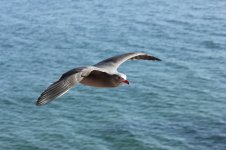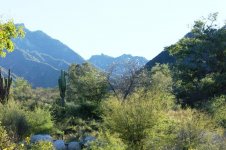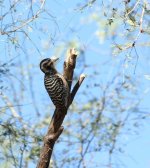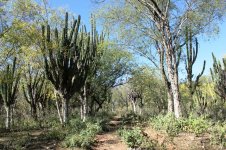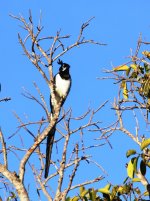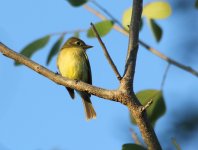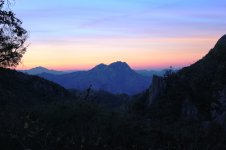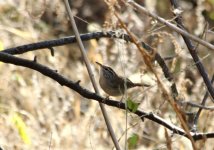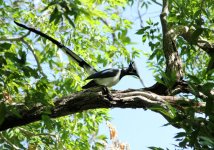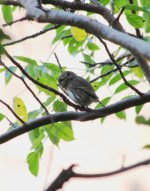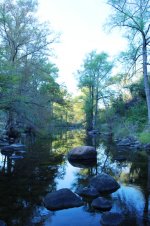ovenbird43
Well-known member

Several months ago on the Arizona/New Mexico birding listserv I learned about the Christmas Bird Counts in Alamos and Reserva Monte Mojino, both in southern Sonora, Mexico; the offer of West Mexican endemics was too much to pass up and I was determined to go. After all, now that I live in Tucson, it's only a little over 8 hours to drive to Alamos... according to Google Maps, anyway, miles-long truck backups over water rights not withstanding.
This was my fourth visit to Mexico, with previous visits to San Luis Potosi (twice, non-birding fieldwork over a decade ago) and Chiapas. I had never driven my car into Mexico before, but I figured if I survived a month of driving a rental around South Africa, I could handle Mexico, so I posted an offer on the local listserv to drive and take three others.
The following information is mostly for anyone interested in planning a similar trip, so those for whom this is irrelevant may want to skip to later posts about the trip itself.
Logistics
Driving to Alamos
David and Jen McKay of Solipaso tours (www.solipaso.com)/ El Pedregal in Alamos have written very detailed directions for the drive from Nogales to Alamos. I believe they are on the website somewhere, but if not I'm sure they would be happy to provide them. One thing that was rather uncertain was the ever-changing car permitting process. There is supposed to be a Sonora-only car permit (never mind that it costs the same as a federal permit and the granting facility is located in southern Sonora.... so the point of that is?), but even with a native Spanish-speaking friend to help me navigate the process, we ended up getting the federal permit issued at the same location as the tourist visas, 21 km beyond the border. As of late 2012 this now requires a $300 USD !! deposit (plus the $50 fee), of which I was unaware before arriving. Supposedly this transaction was cancelled when I left the country- if you are returning to the US in your own car, watch for the rather unofficial-looking booths immediately across from the tourist visa facility, you have to pull off the road and go through this booth to get your deposit refunded.
Driving in Mexico - general
Driving in Sonora was generally very easy- I dare say easier than in many places within the US, as there seemed to be far fewer distracted drivers. The main toll highway south is currently under construction, and many of the older sections are potholed, but it's not too bad. Watch for speedbumps that may or may not be well-marked while passing through towns. While getting gas, I always watched the attendant carefully to make sure the pump was set back to zero before they began fueling, but had no issues.
Of course, there were exceptions that lent a sense of adventure to driving my own car into Mexico. There is currently some dispute over water rights (I don't know the full details), and in demonstration one group is stopping all commercial truck traffic at the tiny village of Vicam between Guaymas and Cuidad Obregon (apparently they let the trucks pass at 5 pm daily). They let passenger cars go by, but this is no easy task when hundreds of semis are occupying both lanes for kilometers in either direction. The solution? Just drive over the median and drive against traffic on the other side. If the median happens to be a ditch where you need to cross, well, tough luck. I've taken my Saturn on some pretty crazy roads before, so I knew what it was capable of and managed to get across said ditch with no more than an uncomfortable scraping sound and proceeded to drive against traffic into Vicam- but lots of other cars were doing that, so no big deal, right?
Stops along the way
On the way to Alamos we stopped at San Carlos, a small town by Guaymas, for lunch and a quick bit of birding. This is a rather touristy but quiet town on the Sea of Cortez, and we stopped to eat at Charley's Rock which is on the main road into town from the highway. The food was decent and the view incredible, the restaurant being situated on the beach with the likes of Blue-footed Boobies flying by while you eat. We ended up staying overnight in San Carlos on the way back in order to break up the drive (excellent idea in itself) and to do some birding- more on that later.
For a late morning snack we had some delicious tacos at a random taco truck in Hermisollo- in general, I highly recommend stopping at a taco/Sonoran hot dog truck. Cheap, fast, and delicious.
With the holidays (plus anniversary for my husband and I) coming up, I may be slow to fill in the rest of the report. We'll see. In the meantime, here are a couple of photos- Heerman's Gull and tropical deciduous forest.
This was my fourth visit to Mexico, with previous visits to San Luis Potosi (twice, non-birding fieldwork over a decade ago) and Chiapas. I had never driven my car into Mexico before, but I figured if I survived a month of driving a rental around South Africa, I could handle Mexico, so I posted an offer on the local listserv to drive and take three others.
The following information is mostly for anyone interested in planning a similar trip, so those for whom this is irrelevant may want to skip to later posts about the trip itself.
Logistics
Driving to Alamos
David and Jen McKay of Solipaso tours (www.solipaso.com)/ El Pedregal in Alamos have written very detailed directions for the drive from Nogales to Alamos. I believe they are on the website somewhere, but if not I'm sure they would be happy to provide them. One thing that was rather uncertain was the ever-changing car permitting process. There is supposed to be a Sonora-only car permit (never mind that it costs the same as a federal permit and the granting facility is located in southern Sonora.... so the point of that is?), but even with a native Spanish-speaking friend to help me navigate the process, we ended up getting the federal permit issued at the same location as the tourist visas, 21 km beyond the border. As of late 2012 this now requires a $300 USD !! deposit (plus the $50 fee), of which I was unaware before arriving. Supposedly this transaction was cancelled when I left the country- if you are returning to the US in your own car, watch for the rather unofficial-looking booths immediately across from the tourist visa facility, you have to pull off the road and go through this booth to get your deposit refunded.
Driving in Mexico - general
Driving in Sonora was generally very easy- I dare say easier than in many places within the US, as there seemed to be far fewer distracted drivers. The main toll highway south is currently under construction, and many of the older sections are potholed, but it's not too bad. Watch for speedbumps that may or may not be well-marked while passing through towns. While getting gas, I always watched the attendant carefully to make sure the pump was set back to zero before they began fueling, but had no issues.
Of course, there were exceptions that lent a sense of adventure to driving my own car into Mexico. There is currently some dispute over water rights (I don't know the full details), and in demonstration one group is stopping all commercial truck traffic at the tiny village of Vicam between Guaymas and Cuidad Obregon (apparently they let the trucks pass at 5 pm daily). They let passenger cars go by, but this is no easy task when hundreds of semis are occupying both lanes for kilometers in either direction. The solution? Just drive over the median and drive against traffic on the other side. If the median happens to be a ditch where you need to cross, well, tough luck. I've taken my Saturn on some pretty crazy roads before, so I knew what it was capable of and managed to get across said ditch with no more than an uncomfortable scraping sound and proceeded to drive against traffic into Vicam- but lots of other cars were doing that, so no big deal, right?
Stops along the way
On the way to Alamos we stopped at San Carlos, a small town by Guaymas, for lunch and a quick bit of birding. This is a rather touristy but quiet town on the Sea of Cortez, and we stopped to eat at Charley's Rock which is on the main road into town from the highway. The food was decent and the view incredible, the restaurant being situated on the beach with the likes of Blue-footed Boobies flying by while you eat. We ended up staying overnight in San Carlos on the way back in order to break up the drive (excellent idea in itself) and to do some birding- more on that later.
For a late morning snack we had some delicious tacos at a random taco truck in Hermisollo- in general, I highly recommend stopping at a taco/Sonoran hot dog truck. Cheap, fast, and delicious.
With the holidays (plus anniversary for my husband and I) coming up, I may be slow to fill in the rest of the report. We'll see. In the meantime, here are a couple of photos- Heerman's Gull and tropical deciduous forest.




